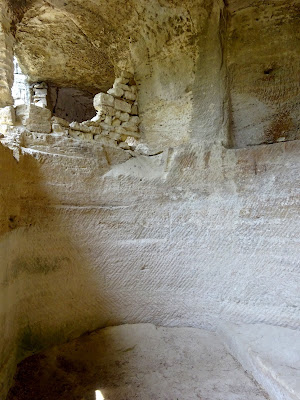L'Abbaye troglodytique de Saint-Roman, or the Troglodytic Abbey of Saint-Roman, Beaucaire, Gard (30), consists of calcareous rocks originally occupied (pre-historically) by tribes of hunters. Towards the end of the fifth century increasing numbers of hermits (possibly followers of Saint Roman) occupied the rock. From the seventh to the eighth century the inhabitants here lived a monastic life-style on a line with the Desert Fathers, becoming a Benedictine abbey, enlarging the natural cavities and creating a chapel and monastic cells. The abbey lost its independence in the eleventh century but its prestige and its history still held it in great esteem. However, in 1538 the monks left Saint-Roman, which had been sold privately, and a kind of castle built over the former religious property. The abbey had been abandoned for very many years when La Société d'Histoire et d'Archéologie de Beaucaire began excavations in the 1960s. It was declared a Monument Historique in 1991.
The entrance to the chapel.
Inside the abbey.
The abbatial seat.
Hewn out of the rock, 152 tombs are still visible.
And from the necropolis there is a commanding view of the River Rhône and beyond. A little to the left in the middle ground is the Vallabrègues dam: Vallabrègues, in the background to the left of the dam, is the only commune on the left bank of the Rhône which is in the département of Gard. Frédéric Mistral was influenced by the basket makers of Vallabrègues in the creation of the main male character Vincent in his narrative poem Miréio.
The entrance to the chapel.
Inside the abbey.
The abbatial seat.
Hewn out of the rock, 152 tombs are still visible.
And from the necropolis there is a commanding view of the River Rhône and beyond. A little to the left in the middle ground is the Vallabrègues dam: Vallabrègues, in the background to the left of the dam, is the only commune on the left bank of the Rhône which is in the département of Gard. Frédéric Mistral was influenced by the basket makers of Vallabrègues in the creation of the main male character Vincent in his narrative poem Miréio.
Monastic cells.
The wine press for the peasants who cultivated the surrounding fields.
La Grande Salle, which was originally on three levels, the bottom one probably serving as a stable.














2 comments:
This dragged up some hidden memories - I stayed in Beaucaire for a couple of weeks in 1988 or 89 and visited the troglodyte abbey but had completely forgotten about it until I saw this. Some nice pictures, especially the one with the sunlit back wall.
Thanks for this. I wonder if it was as badly signposted then as if this now. We parked near a tiny tunnel about a mile from it, asking ourselves if we should go through it or go somewhere else. Others going there had the same problem.
Post a Comment